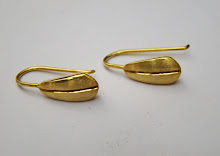Tuesday, October 23, 2012
René Lalique
I thought I'd share a little about one of my favourite jewellery designers, René Lalique. He was born in 1860 in rural France and by the turn of the century at age 40 he was one of the most celebrated jewellers in the world, renowned as an art nouveau artist and designer.
At age 16 René became an apprentice to one of Paris's leading jewellers at that time, Louis Aucoc, and whilst working there he studied at the Ecole des Arts Decorative.
In 1887 he went to college in Sydenham, England and on his return to Paris he worked designing jewellery for a relative and also spent time studying under the sculpture Justin Lequien
By 1881 René was working as a freelance jewellery designer for such names as Cartier and Boucheron. Lalique's designs were greatly influenced by the natural world. He used many materials not generally used in the making of high end jewellery such as glass, horn, semi-precious gemstones, enamel and pearls
Lalique only used expensive gemstones if they enhanced what he was creating, his jewellery was not designed as a carrier for expensive stones, each individual piece was a wearable work of art in its own right.
From a design perspective he had the mind of a true artist and from a goldsmithing perspective his skill was astonishing!
Wednesday, May 2, 2012
The Facts White Gold
I have been asked so often about this subject that it prompted me to write this post about it.
White gold is not a naturally occurring metal, it is made by alloying yellow gold in various proportions with other white metal alloys to create a "whitish" gold.
For example a very common grade of metal used in this country is 18ct white gold. 18ct white gold is made up of 18 parts of yellow gold and 6 parts of other white metal alloys. The finished metal is made up of 24 parts in total, 18 of which are yellow gold so naturally the finished product has a yellowish hue, this is the natural colour to 18ct white gold. In order to give it its bright white finish it has to be rhodium plated, a process of plating rhodium (a platinum alloy) to the white gold to make it white. As this is a plating process it does wear off revealing the natural colour underneath. I would recommend replating your 18ct white gold rings perhaps once or maybe even twice a year depending on how hard wearing you are on your jewellery.
14ct white gold would need to be plated less often as it is 14 parts yellow gold and therefore less yellowish to start with. I hope this has been helpful and not too technical. Ill explain the rhodium plating process in the next blog. If anyone has any questions please do not hesitate to contact me. Addrianna
For example a very common grade of metal used in this country is 18ct white gold. 18ct white gold is made up of 18 parts of yellow gold and 6 parts of other white metal alloys. The finished metal is made up of 24 parts in total, 18 of which are yellow gold so naturally the finished product has a yellowish hue, this is the natural colour to 18ct white gold. In order to give it its bright white finish it has to be rhodium plated, a process of plating rhodium (a platinum alloy) to the white gold to make it white. As this is a plating process it does wear off revealing the natural colour underneath. I would recommend replating your 18ct white gold rings perhaps once or maybe even twice a year depending on how hard wearing you are on your jewellery.
14ct white gold would need to be plated less often as it is 14 parts yellow gold and therefore less yellowish to start with. I hope this has been helpful and not too technical. Ill explain the rhodium plating process in the next blog. If anyone has any questions please do not hesitate to contact me. Addrianna
Subscribe to:
Comments (Atom)












